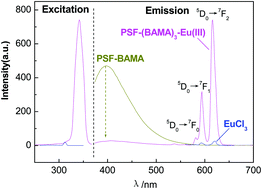Effects of structures of bidentate Schiff base type bonded-ligands derived from benzaldehyde on the photoluminescence performance of polymer–rare earth complexes
Abstract
Two kinds of bidentate Schiff base ligands derived from benzaldehyde, benzaldehyde/m-aminophenol (BAMA) type and benzaldehyde/glutamic acid (BAGL) type ligands, were synchronously synthesized and bonded on the backbone of polysulfone (PSF) through molecular design and by polymer reactions, and two functional polymers, PSF-BAMA and PSF-BAGL, were obtained. Then two series of novel luminescent Schiff base-type polymer-rare earth complexes were prepared via coordination reactions. In this work, the effects of the structures of the bonded ligands on the photoluminescence performance of the complexes were investigated in detail, and for the different photophysical properties of the prepared complexes, relevant theoretical explanations were given. The experimental results show that the bonded ligand BAMA can strongly sensitize the fluorescence emission of Eu(III) ions, and the binary complex PSF-(BAMA)3–Eu(III) emits strong red fluorescence under UV light. The reason for this lies in the fact that a larger conjugate π-bond system is contained in the structure of BAMA, and so the triplet state of BAMA can be matched with the resonant energy level of the Eu(III) ion. While the bonded ligand BAGL can effectively sensitize the fluorescence emission of Tb(III) ions, the binary complex PSF-(BAGL)3–Tb(III) exhibits very strong green fluorescence under UV light. The reason is that a smaller conjugate π-bond system is contained in the structure of BAGL and there is a good energy level matching between the triplet state of BAGL and the resonant energy level of the Tb(III) ion. The fluorescence intensities of the two ternary complexes, PSF-(BAMA)3–Eu(III)–(Phen)1 (phenanthroline, Phen) and PSF-(BAGL)3–Tb(III)–(Phen)1, are much stronger than that of the corresponding binary complex because Phen as the second ligand has two effects, the effect of synergistic coordination with the first ligand and the effect of replacing the coordinated water around the central ion, and it has been confirmed by fluorescence spectroscopy and thermogravimetric analysis.



 Please wait while we load your content...
Please wait while we load your content...